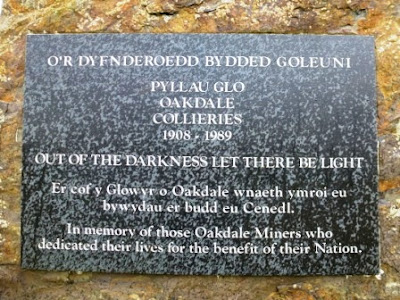Today, although the weather was not as pleasant as yesterdays, I was able to return to the old Oakdale Colliery site, to photograph the memorial set up for all the miners who worked there. It is placed in the now verdant verge by the side of a very busy main road
Designed by a local artist, Steve Welchman, it's base is constructed of different colours of stone, supporting three arcs to which a single pit winding wheel has been cut into thirds.
This was to commemorate the three separate shafts that were mined at the colliery. On a separate stone plinth to one side is a simple but evocative bi-lingual plaque, which reads,
Oakdale was, in war time a significant colliery in that it was one of the main training centres for "The Bevin Boys". Ernest Bevin and others at the time, realised the importance of coal mining as regards it's contribution to the war effort. With so many recruited into the armed services, manpower in the mines was much needed. However it provided work not just for the local Welsh community but for those in other countries, displaced by the effect of wartime occupation. Research shows quite a list not only those recruited from other areas of The British Isles but also ... Russians, Ukranians, Slavs, Dutch and by no means least the Poles who proved to be hard working and highly respected miners. After the war had ended some of these "newcomers" happily stayed on and integrated into the area. The need for miners in the heyday of coal, changed communities across Wales in a similar way, even before the war and now apart from just a few working mines it is only memorials like this that remain as a visible reminder to mark the underground darkness of the past, when mole like men burrowed deep underground to provide our nation with fuel.
I read somewhere that the eventual site covered an area of some 400 acres, quite a lot of which has been turned into new industrial estates, but much of it though levelled and regenerated with much planting and seeding (like the area we walked in yesterday) seems very much like wasted ground. Pleasant enough for those who walk or ride across it, but like so many ex-mining areas of Wales, it is now difficult to imagine how the landscape was so drastically different to today, unless of course one was living here at the time as were so many people I know. For them ... only photographs and vivid memories remain.
But to end on a brighter, more colourful note. There is one small plant that seems to thrive on this night dark ground and ... provides, not just brightness but also sweetness ...
The wild strawberry ... what a delicious treat to be found on an old mining site.







No comments:
Post a Comment